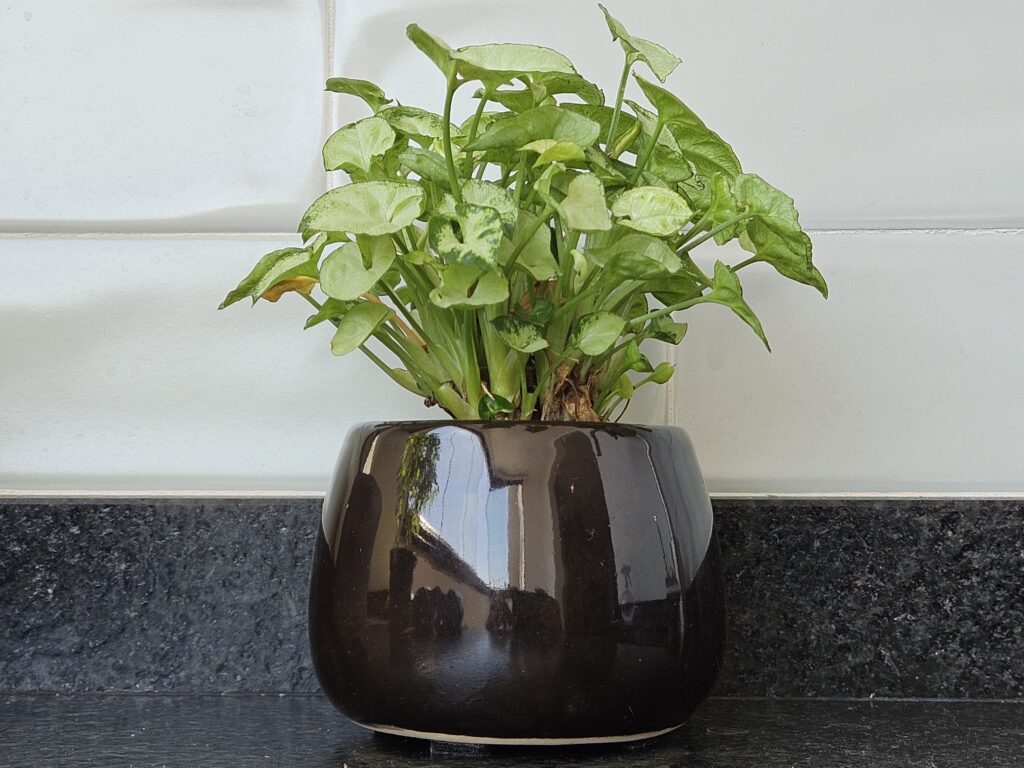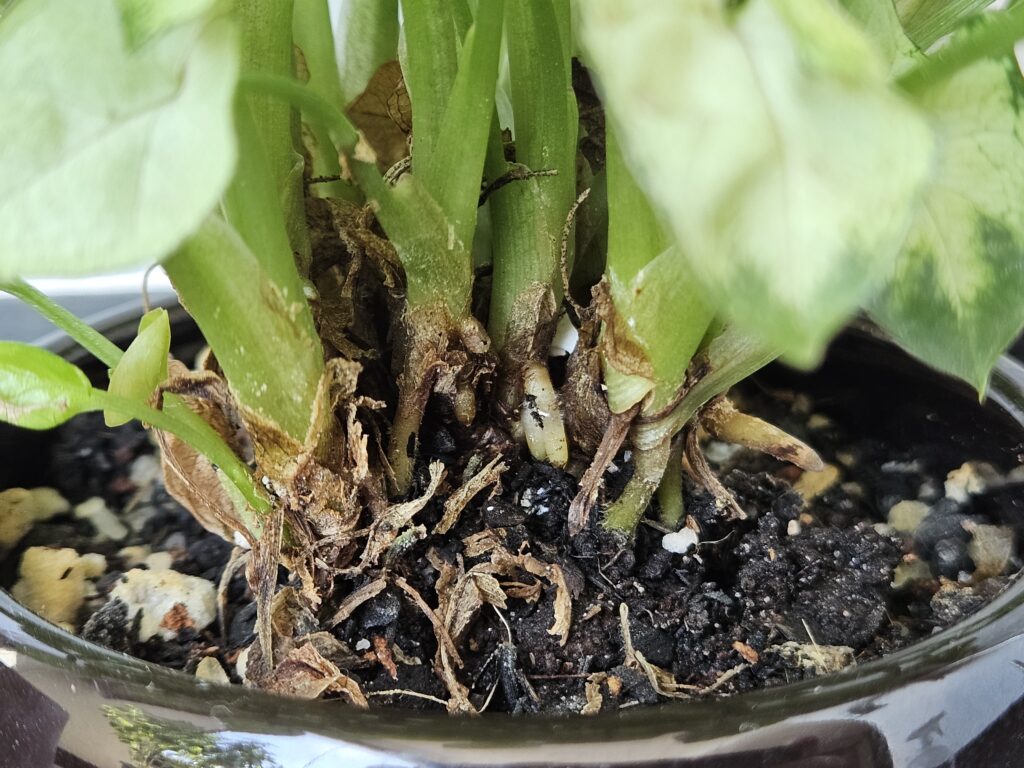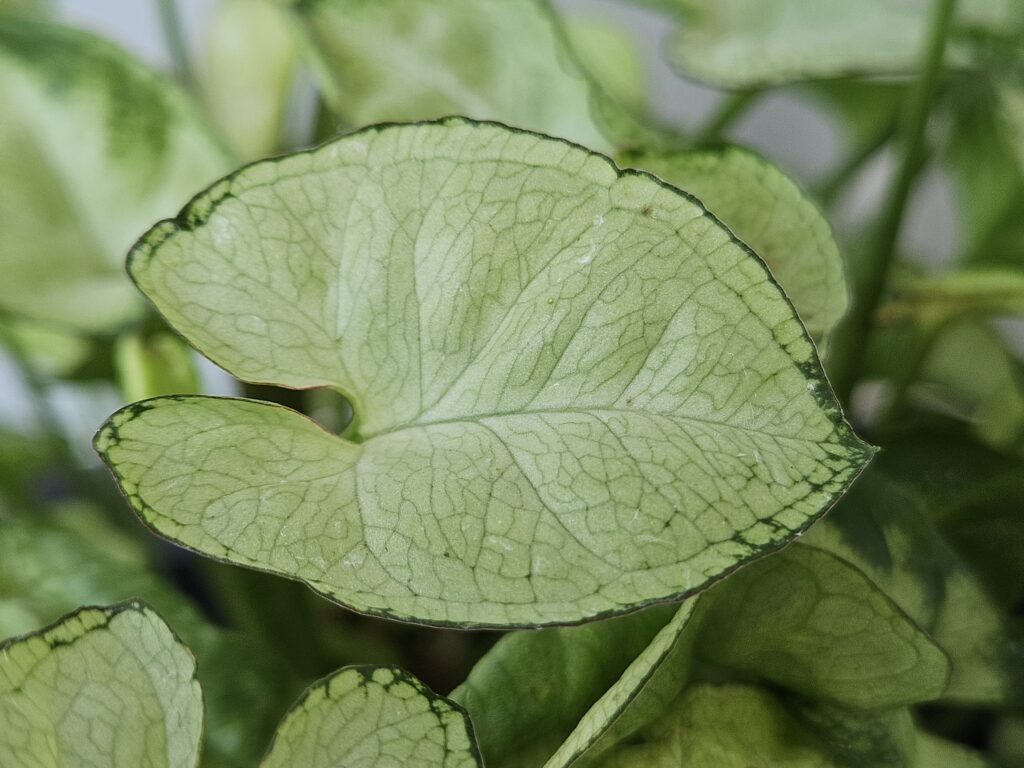
Healthy Syngonium Mini Pixie grown in a compact pot and indoor environment
Plant lovers know: not every space is ideal for creating an indoor jungle. Fortunately, there are species that are perfect for compact spaces — and the Syngonium Mini Pixie is one of them! Small in size but big in charm, this plant enchants with its green leaves and delicate white patterns.
In this article, you’ll learn everything about the Syngonium Mini Pixie: from its features and care tips to decoration ideas and propagation methods to multiply your collection.
What is the Syngonium Mini Pixie?
The Syngonium Mini Pixie is a variety from the Araceae family, native to the tropical forests of Central and South America. Unlike other Syngonium species such as Syngonium Podophyllum, the Mini Pixie was developed to have compact growth and smaller leaves — ideal for small pots, terrariums, and indoor environments.
Key Characteristics:
- Height: 10 to 20 cm
- Leaves: Arrowhead-shaped, green with creamy-white centers
- Growth: Moderate, as a groundcover or trailing plant
- Light: Bright, indirect light
- Toxicity: Toxic to pets if ingested
Botanical Origin and Curiosities
The Syngonium genus originates from Latin American rainforests. First described in the 19th century, it belongs to the same family as philodendrons and anthuriums. Its name comes from the Greek syn (together) and gonu (knee), referencing the jointed growth of its leaf stems.
The Mini Pixie is a cultivated ornamental variant, meaning it doesn’t naturally occur in the wild. It is the result of selective breeding for compact size and aesthetic appeal.
Benefits of Growing Syngonium Mini Pixie
- Compact: Ideal for small spaces like desks, shelves, and kitchens
- Low Maintenance: Tolerates common care mistakes
- Natural Decor: Its elegant leaves suit minimalist, boho, or modern interiors
- Air Purifier: Helps remove pollutants such as formaldehyde and benzene
Differences Between Syngonium Mini Pixie and Other Varieties
There are dozens of Syngonium cultivars on the market, but the Mini Pixie stands out for its size and shape:
| Feature | Mini Pixie | Podophyllum (classic) | Neon Robusta |
|---|---|---|---|
| Size | Small (10–20 cm) | Medium to large (30–90 cm) | Small to medium |
| Leaf Color | Green with white | Solid green | Metallic pink |
| Growth Habit | Compact | Fast-growing climber | Compact |
| Best For | Small pots | Larger indoor spaces | Shelves, desks |
How to Care for Syngonium Mini Pixie
Ideal Light
Prefers bright, indirect light. Place near windows with sheer curtains, avoiding direct sunlight.
Tip: If leaves appear pale or blotchy, move the plant to a brighter, filtered location.
Proper Watering
Only water when the topsoil feels dry. Overwatering can cause root rot.
Suggested frequency:
- Summer: 1–2 times a week
- Winter: Every 10 days or as needed
Soil and Substrate
Light and well-aerated soil is ideal:
- 50% potting soil
- 25% perlite or coarse sand
- 25% coconut fiber or worm castings
Humidity and Temperature
Thrives in humid (50%+) and warm environments.
Ideal range: 18°C to 26°C (64°F to 78°F)
Can wilt under intense air conditioning or heating. Misting helps!
Fertilizing
In spring and summer, apply a balanced liquid fertilizer (NPK 10-10-10) every 30 days. Skip feeding during winter months.
Best Spots for Your Mini Pixie
Office
Freshens up your workspace and improves indoor air quality.
Living Room
Perfect for coffee tables, shelves, and low-light corners.
Bathroom
Enjoys the humidity. Just ensure enough indirect light.
Terrariums and Arrangements
Pair with moss, stones, and other mini foliage in glass containers. Mix with peperomia, pilea, or mini ferns.
Common Problems and Solutions
Yellow Leaves
Likely Cause: Overwatering or poor drainage
Solution: Ensure the pot has drainage holes. If the soil feels soggy, replace it with a fresh mix. Avoid water sitting in saucers.
Tip: Wait until the top half of the soil dries before the next watering.
Dry or Crispy Tips
Likely Cause: Low humidity or hot air drafts
Solution: Use a humidifier, pebble trays under the pot, or mist the air around the plant. Keep away from AC units or heaters.
Wilting Leaves
Likely Cause: Underwatering or heat stress
Solution: Check if the soil is dry. Water moderately and adjust watering based on season and temperature.
Loss of Variegation
Likely Cause: Insufficient light
Solution: Move to a brighter spot with indirect light. Avoid deep shade to preserve its white variegation.
Pests (aphids, mealybugs, mites)
Likely Cause: Poor air circulation or nearby infested plants
Solution: Clean with a cotton swab dipped in mild soap solution or use neem oil spray. Isolate the plant until resolved.
Always inspect leaf undersides, where pests often hide.
How to Propagate the Syngonium Mini Pixie

- Cut a healthy stem with at least one node
- Place in a glass of clean water
- Wait until roots reach 3–5 cm (1–2 inches)
- Transfer to a pot with fresh substrate
Change water every 3 days. Keep soil slightly moist for 2 weeks after transplanting.
Creative Decoration Ideas with Mini Pixie
- Use white or terracotta ceramic pots to contrast its green leaves
- Create a centerpiece using 3 small pots with different species
- Place on stacked books for added height and charm
- Build a mini terrarium with LED lighting under cabinets
Quick Care Guide
| Care Element | Recommendation |
| Light | Bright, indirect |
| Watering | When topsoil is slightly dry |
| Soil/Substrate | Light and well-draining |
| Humidity | Medium to high (50–70%) |
| Temperature | 18°C–26°C (64°F–78°F) |
| Fertilizing | Monthly during spring and summer |
| Pruning | Optional to control shape and fullness |
| Propagation | Water propagation via stem cuttings |
Fun Facts About the Syngonium Mini Pixie
Feng Shui Energy
In Feng Shui, Syngonium is believed to attract balance and positive energy. Its flowing, upward growth symbolizes vitality and harmony between yin and yang. It’s often placed in entryways or meditation corners.
Feng Shui tip: Place your Mini Pixie in the east area of your home to enhance personal growth and well-being.
Evolving Leaf Shapes

As the plant matures, its leaf shape naturally changes — from simple arrowheads to lobed, more complex forms. While the Mini Pixie shows subtle transitions due to its compact size, this evolution reflects its developmental stages and is prized by collectors.
Aroids in the Same Family
The Syngonium is a member of the Araceae family, alongside popular houseplants like Anthurium and Philodendron. These plants share traits such as ornamental foliage, ease of care, and similar flowering structures with spadix and spathe.
Their shared ancestry makes Mini Pixie resilient, beginner-friendly, and a visually pleasing addition to any green collection.
Conclusion
The Syngonium Mini Pixie is one of the best plants for compact living. Beautiful, resilient, and simple to care for, it brings a tropical, decorative flair to any space. With this guide, you’re ready to grow and enjoy your Mini Pixie confidently.
Add one to your collection and share the green joy!
FAQ – Frequently Asked Questions
Does the Mini Pixie grow tall?
No. It stays compact, ideal for small spaces.
How often should I repot it?
Every 1–2 years, or when roots fill the pot.
Can it grow only in water?
Yes, but growth will be slower. Soil offers better nutrition.
Is it safe for kids and pets?
No. It contains calcium oxalate, which is toxic if ingested.
Can it be used in hanging pots?
Yes! Though compact, it looks beautiful.
